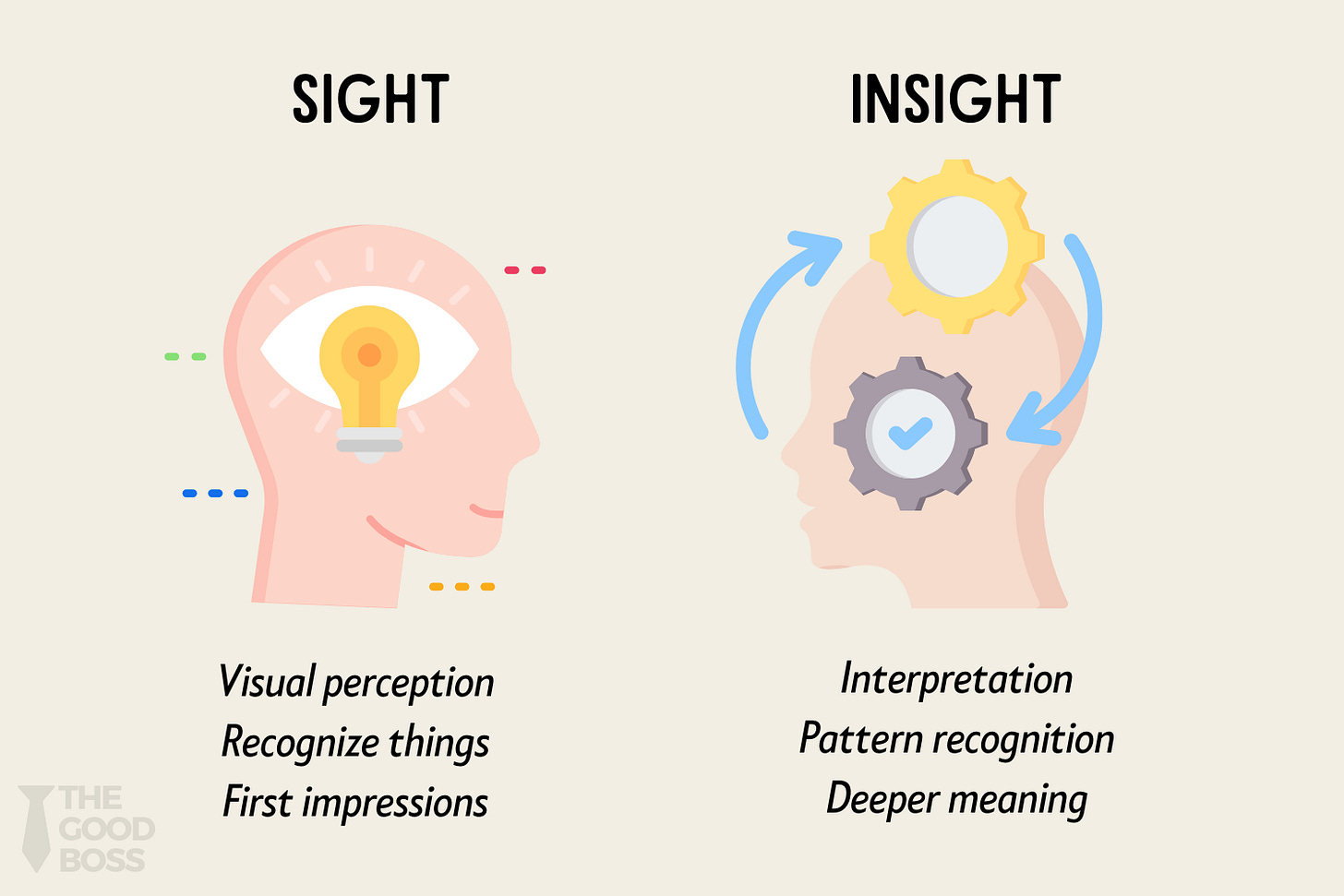Sight vs Insight: Are You Leading With Your Eyes or Your Mind?
The 5-Step Approach: Master the Balance Between Your Gut Instincts and Strategic Thinking
In this issue:
Judging a Book by its Cover
What is Sight vs Insight?
How Sight vs Insight Works in Leadership
Real-Life Scenarios: Sight vs Insight in Action
How to Apply Insight in Leadership
The 5-Step Approach
Common Mistakes to Avoid
The Sight vs Insight Application Worksheet
Recommended Resources
Final Thoughts
✨
Judging a Book by its Cover
Imagine you’re at the airport, about to board a flight.
With ten minutes to spare, you wander into a bookstore near your gate, hoping to find a good read for the journey. As you scan the shelves, certain books catch your eye—ones with vibrant covers, intriguing titles, or a familiar author’s name.
You pick up one, flip it over, glance at the back summary, check the price tag, and glance at the time. Two minutes left. You rush to the cashier and make your purchase.
You chose the book based purely on what you saw.
Now, imagine a different scenario. What if you had 30 minutes instead of 10? You’d take your time—browsing multiple books, reading a few pages, checking reviews, even comparing different genres.
Your decision wouldn’t be based on appearance alone; it would be deeper, more thoughtful.
This is the difference between sight and insight.
What is Sight vs Insight?
Sight is your ability to perceive the world visually. It allows you to see colors, shapes, and movement. It helps you navigate your surroundings, recognize people, and gather information.
Insight, on the other hand, goes beyond observation. It’s your ability to interpret what you see, recognize patterns, connect ideas, and uncover deeper meaning. Insight enables you to move beyond surface-level judgments and make well-informed, strategic decisions.
Let’s look at some hard numbers to drive home the point:
90% of the information processed by the brain is visual. (MIT, 2014)
Humans make first impressions in just 7 seconds based purely on visual cues. (Princeton University, 2006)
In the airport bookstore example, sight made you pick a book based on its cover. Insight would have guided you to the right book for your interests and needs.
We make choices like this every day—sometimes using just sight, sometimes using insight.
The key is knowing when to rely on each.
How Sight vs Insight Works in Leadership
As a leader, how you make decisions determines the success of your team and organization. Do you rely purely on what’s visible on the surface, or do you dig deeper to uncover the full picture?
Sight: Quick but Superficial Judgments
Sight-based leadership is reactionary. Leaders who operate this way rely on what’s immediately visible and make snap decisions without understanding the underlying context.
Examples of sight-based leadership:
Promoting an employee because they are the most outspoken in meetings, rather than evaluating their actual contributions.
Making hiring decisions based on a polished resume, rather than digging into whether the candidate truly has the skills and mindset for the role.
Reacting to a dip in team productivity by assuming people are slacking off, rather than investigating if they are overwhelmed or facing systemic challenges.
These surface-level decisions may seem efficient, but they often lead to misalignment, frustration, and poor results.
You may cringe reading these, but the fact is that these are very common in practice.
Insight: Thoughtful, Informed Decision-Making
Insightful leaders take the time to gather data, understand context, and recognize deeper patterns. They don’t just react to what they see; they ask questions, seek feedback, and analyze the root causes.
Examples of insight-driven leadership:
Instead of assuming a struggling employee is unmotivated, an insightful leader will have a conversation to understand what’s going on. Are they unclear about expectations? Are they dealing with personal challenges?
When hiring, an insightful leader won’t just look at qualifications but will assess a candidate’s mindset, adaptability, and alignment with company values.
Instead of making knee-jerk decisions based on financial reports, an insightful leader will dig into market trends, customer behavior, and internal operations to make strategic moves.
And what you get with these is better decisions, stronger teams, and a culture of trust.
Real-Life Scenarios: Sight vs Insight in Action
Let’s look at real-world examples where sight vs insight makes all the difference.
Scenario 1: Conflict Resolution
Sight-based approach: A leader hears that two employees had a heated argument. Without investigating further, they punish both individuals equally and move on.
Insight-based approach: The leader listens to both sides, understands the root of the disagreement, and works to address the underlying issue, whether it’s miscommunication, workload imbalance, or differing work styles.
Scenario 2: Business Strategy
Sight-based approach: A company sees that a competitor is launching a flashy new product and rushes to copy it.
Insight-based approach: The leadership team analyzes the market demand, customer needs, and internal capabilities before deciding whether a similar move aligns with their long-term vision.
Scenario 3: Employee Performance
Sight-based approach: An employee frequently stays late at the office. The leader assumes they are highly dedicated.
Insight-based approach: The leader checks in to see why they’re working late. They discover the employee is struggling with time management, leading to burnout, and helps them find a sustainable workload balance.
How to Apply Insight in Leadership
As a leader, knowing when and how to apply “Insight” vs. “Sight” could mean the difference between failure and success in your role.
Next, we will:
Learn the 5-step approach to applying Insight in your role as a leader
Review some common mistakes to avoid when applying this framework
Put the power of this framework into practice with The Sight vs Insight Application Worksheet, which includes step-by-step prompts to guide you through the application process (🎁 Paid subscribers enjoy FREE access to the entire collection of worksheets! Not a paid member? Upgrade now.)
Review additional resources to further your understanding
Close out with some key takeaways


